>note
Carbohydrate may destroy human beings
- Life science reviewed from restriction of taking glucide -
Cat: SCI
Pub: 2013
#: 1606b
Makoto Natsui (夏井 睦)
16515u/18227r
Résumé
Remarks
>Top 0. Introduction:
- Restriction of taking carbohydrate - amazing diet method
- Homo sapiens could be understand by what they have eaten.
0. 序文:
- 糖質制限は驚異のダイエット法
- 何を食していたかでホモサピエンスがわかる
>Top 1. Impact of restriction of taking carbohydrate
- Drastic diet is realized by restriction of glucide; as much as 10 kg!
- as wel as improving hypertension and hyperlipermia, as well as restricting LDC cholestrol
- Less carbonhydrate food does not cause getting sleepy after meal.
- Food detention period in a stomach; carbonhydrate is longer than meat or fish.
- vomits are mostly carbonhydrate and vegetables.
- Improving SAS (Sleep Apnea Syndrome)
- >Top Carbohydrate sensor:
- brain tends to be reject taking carbonhydrate.
- carbonhydrate seems poisenous to body.
- to become 'carbonhydrate restrictor'
1. 糖質制限の威力:
- ダイエットに効果:
- さらに高血圧、高脂血症、LDLコレステロールの抑制に効果
- 糖質を少なくすると食後眠くならない。
- 食物滞留時間:糖質は肉・魚より長い
- 嘔吐は主に炭水化物と野菜
- 睡眠時無呼吸症状の改善
- 糖質センサー:
- 大脳が糖質を拒否する傾向
- 糖質は体に毒
- 糖質制限者になる。
>Top 2. Basic knowledge of restriction of carbohydrate:
- Carbohydrate is a nutrition which raises blood sugar level.
- Glucose is most effective in raising blood sugar level.
- dietary fibre; humans cannot digest.
- fructose (fruit sugar) does not raise blood sugar level, but changes into neutral fat.
- artificial sweetener is not in this category.
- protein and fat do not raise blood sugar level.
- Foods should be avoided:
- carbohydrate such as rice, pasta, noodles, and bread
- root crops (vegetables) such as corns, potatoes, carrot, lotus root, etc.
- fruits
- candy, sweets, snacks, sugar
- sweet drinks like coke, juice, sports drink
- brewed liquor; such as beer, sake, makkori
- Foods not restricted:
- meat, fish, egg
- soybeans product
- vegetables
- mushroom, sea weed
- dairy products; such as cheese, yogurt, milk
- nuts
- oil, mayonnaise, butter
- fried food
- distilled liquor; such as red wine, carbohydrate off beer,
- Stage of restriction of carbohydrate meals:
- Petit-restriction: no carbohydrate in the dinner
- Standard-restriction: no carbohydrate in the breakfast & dinner
- Super-restriction: no carbohydrate in all three meals.
2. 糖質制限の基礎知識:
- 糖質とは血糖値を上げる食品
- 避けるべき食品
- 制限なしの食品
- 糖の種類
- 単糖類, monosaccharides:
- 果糖, fructose
- グルコース(ブドウ糖), glucose
- ガラクトース (脳糖), galactose
- 二糖類:
- 蔗糖, sucrose
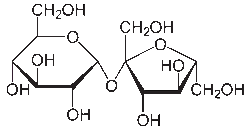
- 乳糖, lactose
- 麦芽糖, maltose
>Top 3. Problems by restriction of carbohydrate:
- The term 'staple food' should be deleted:
- For the Japanese, white boiled rice has been the staple or principal food
- Deletion of this term looks like like 'the table flippering' action for the Japanese.
- Restriction of carbohydrate:
- If restriction of carbohydrate started, there would be no return to the original carbohydrate depending meals, or chubby body.
- no need to stick to three meals a day: two meals or 2.2 meals a day are substantially enough.
- feel a sense of 'not a full stomach, but sufficient'.
- >Top Sugar stacks (www.sugarstacks.com/)
- a slice of bread: 8 cubes of sugar.
- Carbohydrate sensor, or sugar sensor
- Cost of restriction of carbohydrate:
- increase of Engel's coefficient:
- use tofu instead of rice.
- less quantity by restriction of carbohydrate.
- Calorie contained in foods:
- calorie contained in foods and that got by the foods are different.
3. 糖質制限の問題点:
- 角砂糖換算表示: a cube of sugar=4g
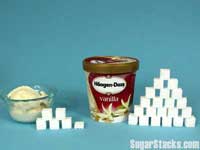
- 食物中のカロリー:
- 食物中のカロリーと食物により摂取するカロリーとは異なる。
>Top 4. Also sprach a restrictionist:
- more cheese, nuts, tofu, small dried fish rather than cake, snack, juice, ice cream, or fried potato
- Various tips:
- the restriction is particularly effective in long driving to avoid being sleepy; only by nuts, non-sugar gum, and black coffee.
- γ-GTP, GOT, GPT index improved
- full marathon by taking breakfast of natto, egg, and yogurt
4. 糖質セイゲニストかく語りき:
- 〇: チーズ、ナッツ、豆腐、小魚
- ×: ケーキ、スナック、ジュース、アイスクリーム、フライドポテト
- 糖質制限による各指標改善
- γ-GTP, GOT, GPT
>Top 5. New horizon seen by the restriction of carbohydrate:
- Getting sleeping after taking carbohydrate:
- insulin is secreted in response to rising of blood sugar level.
- lowering blood sugar level causes sleepy; causes mental fasting.
- starch food feels little sweet; which changed sweet food after eating.
- glucose covered by non-sweet starch skin.
- Is carbohydrate a necessary nutrient?:
- Nutritional science recommends the balanced food: carbohydrate 60, protein 20, and lipid 20%.
- Humans inhere the system of 'gluconeogenesis'
- Humans could produce neither essential fatty acids, nor essential amino acid.
- >Top Luxury taste foods: discretionary items
- not expected as source of nutrients or energy.
- not regards as medicine
- having mental effectiveness
- feel loneliness if not.
- too much having causes dependence or toxicosis symptoms:
- like: liquor (alcohol), tobacco (nicotine), or coffee (caffeine).
- taking sugar require anther sugar.
- ’Carbohydrate addiction':
Requirement of carbohydrate is caused by the requirement of raising blood sugar level, not by hunger.
- Conversion of so-called balanced food:
- 2400 K-Calorie a day: carbohydrate (65%), protein (15%), and total lipids (20%) = 1560: 360: 480 K-Calorie = 390 : 90 : 53 g
- this nutrition was taken by representative food; sugar, chicken fillet, and salad oil respectively, which result:
sugar 390g, chicken fillet 300 g, and salad oil 50g
- Is this really balanced food, recommended by Ministry of Agriculture?
- History of the number of times of meals:
- In Japan, until Kamakura era (12-14C) both worriers and farmers took meals twice a day (only noble men took three times a day.)
- Ordinary people began to take three times after the Great Fire of Meireki (1657), almost all areas of Edo (Tokyo) were destroyed by fire, together with death of about 100,000 people.
- In order to rebuild Edo, most of carpenters and craftsmen gathers from other areas of Japan, who were supplied three times of meals to worth through the day.
- Ordinary people of Edo period had eaten mostly mixed grains with small percentage of rice. Rice was mostly paid as the annual tribute.
- Sushi, soba and tempra became popular fast food in Edo.
- >Top 'Slave of grain':
- carpenters and craftsmen could not eat rice at there home village.
- but they were supplied three time of rice meals at Edo after the Great Fire in exchange for hard working all day.
- this is a life style of 'slave of grain' or slave of rice.
- Had they eaten meals to work or worked to eat?
- Agriculture requires people to work for eating, while hunting and gathering age required people much less works to collect foods.
- In Britain in 19C, sugar was magical food for workers to labor long times.
- most of urban people (including house wives and children) work long hours, who could not have time to prepare traditional home cooking; revolution of eating habit, or new eating style.
- In Europe, the consumption of sugar increased to sustain easy food with full of sugar; tea with sugar, jam, sugar boiled fruit, and cold beef with sugar taste to sustain long hour working (from 06:00 until 19:00)
- Until such industrial revolution ages, sugar was available in noble class only.
- >Top Enormous amount of sugar was imported from large-scale sugar plantation in Caribbean West Indies, whose labor forces were supplied by the slaves from West Africa; 'Notorious Triangular Trade'
- Sugar cane is considered the worst environmental destructive crop, which requires enormous amount of water and nutrients of the soils, as well as hard labor.
- Sugar crop had been sustained by slave labor and environmental destruction.
- Separation of production and consumption causes people to neglect reality of actual sites; 'globalization of food', or 'black box of food production'
- Sugar-rich tea became a magical medicine to eliminate feeling of fatigue and to satisfy the hunger in short time.
- Supply of such sugar-rich food & drinking was very cost-effective measure than raising pay for the factory owner.
- On the other hand, sugar remained in baggase (sugar trash) gave labor incentives for the slaves.
- New combination of tea time food; sugar-rich tea and bisques, sugar-rich coffee and bread with jam; later sugar-rich budding became popular.
- Sugar was regarded as primary health food.
- Furthermore, addictiveness to sugar functioned as controlling the labor.
- >Top Narcotic effect: labors became obscure which was major object; to earn money or to eat sugar.
- Similarly, during WWII, soldiers were supplied tobacco, and during Vietnam war, US soldiers were supplied even Marijuana.
5. 糖質制限すると見えてくるもの:
- 糖質摂取後の睡魔
- 澱粉もわずかに甘味がある。
- 甘くない澱粉の皮を被ったブドウ糖
- 炭水化物は必須栄養素か?
- 栄養学によるバランス食事:
炭水化物:蛋白質:脂質=60:20:20%
- 人間は生来ブドウ糖生成可能。
- 必須脂質、必須アミノ債は生成不能
- 炭水化物は"嗜好品"
- 栄養源・エネルギー源ではない
- 薬でもない
- 精神的な効果がある
- ないと寂しい。
- 大量に摂取すると依存症・中毒症がある
- 酒、たばこ、コーヒー
- 糖質の摂取はさらなる糖質を要求
- "糖質中毒"
糖質の欲求は血糖値を上げるため。
- バランスの取れた食事:
- 2400 Kカロリー/日。
炭水化物:蛋白質:脂質比では
1560: 360: 480 Kカロリー
- これを砂糖、鶏のささみ、サラダ油で摂取するとすれば
砂糖 390g:鶏肉 300g:サラダ油50g
- この数値は農水省推奨のバランス食事か?
- 歴史的な食事の回数
- 日本では鎌倉時代まで、武士・農民は1日2食 (貴族のみ1日3食)
- 一般庶民が1日3食となったのは、明暦の大火 (1657) 以降。当時江戸の大半が焼失、使者約10万人。
- 江戸復興のため全国から大工・職人が集結。長時間集中作業のため米の飯1日3食を提供。
- また江戸では、寿司・そば・天ぷらなどファーストフードが登場。
- "穀物の奴隷"
- 大工・職人の出身村では米飯はほとんどなし。
- 長時間労働と引き替えに1日3食の米飯を提供。
- 19Cの英国では砂糖が労働者階級に普及
- 家族ぐるみの長時間労働により伝統的な家庭料理が、砂糖の多い簡易な食事に変更:食事革命
- 砂糖入り紅茶、ジャム、砂糖煮野菜、砂糖味の冷肉が長時間労働を支えた(06:00〜19:00)
- それまで砂糖は貴族階級のみ摂取。
- 西インド諸島での砂糖プランテーション、労働力は西アフリカからの奴隷; 三角貿易
- さとうきびは環境破壊作目。大量の水と土壌の栄養、さらに辛い労働。
- 生産と消費の分離により、それぞれの現場意識が希薄:食のグローバリゼーションまたはブラックボックス化
- 砂糖漬けは疲労回復の魔法
- さらに砂糖中毒は労働管理に寄与
- 一方でサトウキビ農園の奴隷にとってもサトウキビ絞りかすの甘味は辛い労働への報酬となった。
- 砂糖入り紅茶、ビスケット、砂糖入りコーヒー、ジャム付きパン、砂糖入りプディンが人気に
- 当時砂糖は、健康食品だった。
- 麻薬性:
同様に、第二次大戦の兵士にタバコを配給、ベトナム戦争では、米軍兵士にマリファナも配給。
>Top 6. Amount of calories in food:
- A healthy man of 60kg has 4.2 litter blood in total. Glucose is contained about 100mg/dl. The total glucose is 4.2 g, which is equivalent a piece of cube sugar.
- the major consumer is brain, while other organs use fatty acid as energy source.
- as the brain is activated 24 hours, the constant mechanism maintaining glucose density at 100 mg per dl is needed.
- Such glucose is supplied from gluconeogenesis process of protein; another glucose source is supplied from stocks of liver and muscle (for all contingencies).
- ATP (Adenosine TriPhosphate):
To dissolve materials, energy is needed; fatty acid is β-oxidized and infiltrated into cells, where ATP is produced by mitochondria.
- This is the mechanism of getting slim by restriction of carbohydrate. If enough carbohydrate was eaten, too many glucose was produced, excessing the limit of 100mg/dl level; where no more gluconeogenesis occurs. Furthermore excess glucose content in the blood causes various poisonous situation ('glucotoxity').
- Historically, CO2 was discovered in 1754, O2 was 1774; mechanism of combustion (and also rusting, or collectively oxidation) was clarified (negation of frogiston)
- Law of conservation of energy was proposed in 17C (vis viva, etc.); metabolic mechanism and the function of ATP was gradually clarified.
- Thus, nutrients are dissolved and absorbed at the digestive tract, then converted to ATP in a cell, becoming thermal and kinetic energy and materials for new tissues.
- In 1883, Rubner proposed:
- Calorie of foods=(calorie of foods burnt in the air) - (calorie of excreta burnt in the air)
- Physical calorie was; protein 5.56, carbohydrate 4.1, lipid 9.45 K-calorie per gram.
- actual intake of thermal energy depend on each metabolism and absorption.
- Artwater calculated the average absorption rate is protein 92%, carbohydrate 97%, and lipid 95% respectively, and calorie loss by excretion of protein was 1.25 KC.
- Thus: protein 3.87, carbohydrate 3.98, and lipid 8.98 KC; approximately protein 4, carbohydrate 4, and lipid 9 KC per gram.
- Thereafter, considering dietary fibre which is not digestible; revising ethanol 7KC, organic acid 3 KC, sorbitol or xylitol are 3 KC, dextrin 1 KC.
- Tubeworm (Lamellibrachia), Annelida:
- lives at deep-sea where hydrocarbons (oil and methane) are leaking out of the seafloor;
- has neither mouth nor anus; intake calorie is zero.
- but they are living without sunlight.
- entirely reliant on internal sulfide-oxidzing bacterial symbionts.
- its larva has a mouse for the first 3 days, and absorb sulfur bacteria from sea.
- How do mammals get energy?:
- domestic cattle, typical ruminant; intake energy is almost zero.
- particularly adapted to eating plant food
- component of plant: water 70%, other 30%; 13 to 12 of dried weight is cellulose, polysaccharide.
- no animals (including insects) can digest and absorb cellulose by own digestive enzyme.
- a cattle has four stomachs: 1) rumen; 2) reticulum, 3) omasum, 4) abomasum; only fourth abomasum secrete gastric acid.
- symbiotic microbe dissolve cellulose to glucose, then ferment to various fatty acid and amino acid, then transfer them to the fourth stomach, abomasum.
- a cattle also secretes urea in the first three stomachs, where symbionts synthesize protein.
- a cattle only grinds plant food, then makes symbionts digest cellulose, only secreting digestive enzymes in abomasum. (very effective digesting mechanism)
- horse: is still wasteful as a herbivorous animal.
- has only one stomach; has long colon.
- a horse can utilize short-chain fatty acids like acetic acid, which are derived from symbiont bacteria.
- a horse excretes the symbiont bacteria, while cows can absorb their proteins; therefore horses need to eat grain, tubers and roots, and legume family.
- rabbit:
- has long cecum, where many symbiont bacteria live.
- gets nutrients by eating faeces.
- koala:
- has long cecum, where many symbiont bacteria live.
- takes sleeping around 20 hours a day to save energy.
- Dynamic equilibrium:
- frequent decomposition and synthesis in organizational, cellular, and molecular level; osteoclast and osteoblast of bones.
- herbivorous or carnivorous animals:
- herbivorous:
- plant contains much less protein and fatty acids.
- needs to have complicated digestive system including having symbiont bacteria.
- carnivorous:
- other animals contain ideal protein and fatty acids.
- can digest by own digestive enzymes, with shorter intestinal tract.
- can have lighter body and agility in action, but rather difficult to catch bait animals.
- trade-off relationship between action to get food and digestion of food.
- human beings:
- has inappropriate digestive system for pure vegetarian.
- has 100T composed of several hundred kind of bacteria (total weight about 1.5 kg); the number of total cell is about 60T.
- more than half weight of feces are intestinal bacteria.
- intestinal bacteria produce vitamin-K, B3, B6, B7, B9, and also short-chain fatty acid; having exclusion function against foreign bacteria.
- omnivorous animals have many kinds of foods, which can be adaptable to environmental changes; but digestive system should be complicated preparing own more digestive enzymes.
- carnivorous giant panda changed to herbivorous one:
- a hypothesis:
changed rapidly (about a week or so) food from fasting state; by having new intestinal bacteria started to survive in the panda's poor nutritional state.
- the intestinal bacteria started to dissolve cellulose of bamboo and secrete short-chain fatty acid and vitamins.
- but still unknown getting source of protein (amino acids)
- Future possibility of new food:
- food contained cellulose could be alternative food; by having cellulolytic microorganism.
- >Top breast milk:
- human breast milk contains protein 1.1g, fatty acid 3.4g, and carbohydrate 6.87g per 100g milk; within carbohydrate lactose 85% and other oligosaccharide. (humans cannot digest oligosaccharide.)
- oligosaccharide can promote bifidobacteria to fix and increase in baby's intestinal tract.
- oligosaccharide is changed into lactose and short-chain fatty acid such as acetic acid, butyric acid, and propionic acid.
- >Top it is remarkable that neither glucose nor starch are included in the milk; glucose is particularly needed for the growth of baby's brain.
- For mother, it is complicated to produce 130 kinds of oligosaccharide and others.
- during the process of evolution, mammals who can produce oligosaccharide could survive; which contribute to keep intestinal bacteria.
- one unit symbiont= breast milk + newborn baby + enteric pathogen
6. 食物のカロリー数:
- 健康な成人男子の血液量4.2L。
ブドウ糖量は4.2g (角砂糖1個分)
- 主に大脳で消費。
- このブドウ糖は蛋白質からの糖新生による。
- 物質分解にはエネルギーが必要:
ATP (Adenosine TriPhosphate)

- これが糖質制限すると痩せる理由
- 余ったブドウ糖は中性脂肪に変えて脂肪細胞にストックする。
- 1883: 三大栄養素のカロリー計算:
空気中の燃焼熱量−排泄物の燃焼熱量
- その結果、蛋白質4、炭水化物4、脂質9 Kカロリー
- 深海のチューブワーム(ハオリムシ)の生き方:
口・消化管・肛門もない=摂取エネルギーゼロ。
- 体内共生の硫黄バクテリアが鍵
- 幼虫は最初の3日間は口があり、海中の硫黄バクテリアを取り込む。
- 哺乳類はどうエネルギーを得るか?
- 牛:
- 4つの胃、反芻胃
- 植物食: 水分70%、他30%
乾燥重量の13−12はセルロース
- 昆虫を含め動物は、セルロースの分解消化は不能
- 牛は牧草のみを食べて成長
- セルロースを分解する共生菌
- 4番目の胃で消化吸収
- 馬:
- 胃は1つ;結腸が長大
- 共生菌由来の短鎖脂質を消化吸収
- 更に馬は、穀類・芋類を食べる必要あり
- 兎:
- 盲腸が発達し共生菌
- 糞食による栄養摂取
- コアラ:
- 盲腸が発達し共生菌
- 1日20時間睡眠で省エネ
- 動的平衡:
- 組織・細胞・分子レベルでの頻繁な文化と合成
- 草食動物:
- 植物には蛋白質と脂質が少ない
- 消化管の共生細菌・微生物が必要
- 肉食動物:
- 蛋白質・脂質を多く含み理想的
- 腸管の長さも短くて済む
- 獲物の捕獲には俊敏さが必要
- 食料の入手に苦労するか、食料から栄養摂取に苦労するかの違い
- ヒトの場合:
- 完全なベジタリアンには不適な消化管構造
- 但し、ゴリラ・オランウータンは草食; 前者はツルイラクサ、後者は樹皮を主食
- ヒトには100兆個の腸内細菌(細胞は60兆個) 重量は1.5 g kg.
- 糞便の半分以上は腸内細菌
- 腸内細菌はビタミンK, B3, B6, B7, B9を生産。
- 雑食動物は、食物の種類多いので、環境変化への対応できる。但し、消化管の構造は肉食動物より複雑化となり、消化酵素の種類も増大
- 肉食のパンダはなぜ草食化したか?
- ある仮説:
絶食期間後、早期に腸内細菌がパンダの貧栄養状態に住み着いた。
- 但し、蛋白質源については不明
- 母乳
- 母乳成分: 蛋白質1.1g、脂質3.4g、炭水化物6.87g
- 炭水化物の85%は乳糖が95%, 6g、他には三糖以上のオリゴ糖(約130種類)
- オリゴ糖は人間は消化不能
- オリゴ等はビフィズス菌の腸内管への定着を促進
- オリゴ糖は短鎖脂質(酢酸、酪酸、プロピオン酸)を生成
- 母乳にブドウ糖や澱粉が含まれていないことは重要。
- 脳のエネルギー源であるブドウ糖は経口摂取した糖質とは無関係
- 母乳中に130種ものオリゴ糖を生成するのは大変
- 進化のプロセスで哺乳類はオリゴ糖を生成し、腸内細菌を保持
- 母乳+新生児+腸管常在菌はOne unitの共生体
- Why mammals started to suckle?:
- reptiles do not care after hatching.
- the only selection is to bear smaller size baby than the mother; in both oviparous or viviparous.
- then, why mammals raise their baby by breast milk.
- animals which ingest different food than the parents.
- eating same or similar food as the parents:
- fish, reptile, bird, incomplete metamorphosis insect (locust, mantis)
- >Top eating different food from the parents:
- mammal and complete metamorphosis insect
- which need to change specification of digestive tract (weaning period of mammals, or pupal period of insects).
- beetle: larva eats leaf mold, while imago eats sap
- cabbage butterfly: larva eats cabbage (cruciferous vegetable), while imago flower nectar.
- design changing period (in pupa or weaning period) are extremely vulnerable situation.
- Can newborn herbivorous baby survive by eating plants?
- volume of energy and nutrient are determined by the number of symbiotic bacteria; which correspond to the capacity of stomach and intestinal tract.
- half size baby can get 1/8 of energy, while exuding energy is 1/4.
- thus the certain size of newborn baby of herbivorous is needed.
- What about carnivorous baby?
- carnivorous aquatic animals:
- possible, because there are lots of plankton in water (young of fish, larva of crab, etc.)
- carnivorous terrestrial animals:
- difficult to segment soil and microorganism or catch small insects.
- reptiles: having lower basal metabolism, but laying lots of eggs.
- Early mammals had chosen to bear small-sized babies and raising the baby by different food (protein, fatty acid, necessary vitamin, and trace elements.
- liquid or semifluid food is favorable for newborn babies.
- keeping the temperature of surrounding environment of the baby near to the body temperature.
- thus liquid food containing necessary nutrient secreted from parent; that is 'skin secretion'
- >Top Human sweat gland:
- eccrine gland: small sudoriferous gland; found in all skin;
- apocrine gland; large sudoriferous gland; found only in certain locations of the body; axilla (underarm), Montgomery gland (areola and nipples of the breast), ceruminous gland (ear canal), eyelids, wings of the nostril, perianal region, and external genitalia.
- Therapsid, 260 ma, already had apocrine gland.
- ingredients of apocrine gland: protein, carbohydrate, fatty acid like pyruvic acid, iron ion, steroid, lipofuscin pigment, ammonia, urea which are almost same with necessary nutrients for a newborn baby.
- originally developed to keep skin and hair from desiccation.
- mammary gland is made by the concentration of apocrine gland.
- 80% is nutritious casein of the protein included in human breast milk.
- to synthesize casein which is large molecule, particular organization as breast tissue is needed.
- Pederpes: early Carboniferous (359-300 ma) tetrapod 348 ma; regarded as the first terrestrial locomotion.
- the role of skin: to prevent water into body from the difference of osmotic pressure in aquatic life, while to prevent evaporation of body moisture in terrestrial life.
- earlier amphibians could not leave from waterside because of evaporation of body moisture.
- then reptiles appear;
- 1) Sauropsida; reptiles without skin gland, having hard scale which requires molting; such as crocodile, lizard, tortoise, snakes; thereafter leads to birds
- >Top 2) Synapsid; mammal type reptiles with skin gland; such as thrinaxodon, in Triassic (251-200 ma); having keratinized topmost layer of skin, which regularly replaced with new one as well as keeping skin viscous by secretion of skin gland.
- Furthermore, covered by dense hair on the skin, which functions as excellent insulator and defense organ.
- present mammals inherited the set of skin+skin gland+body hair; flexible and supple which are essential to have fetus.
- なぜ哺乳類は哺乳を始めたのか?
- ワニは孵化後は世話をしない。
- 卵生も胎生動物も母親より小さな子供を産む選択しかない。
- 食物は親と同じか異なるか:
- 親と同じものを食べる動物:
- 魚、爬虫類、鳥、不完全変態昆虫(バッタ、カマキリ)
- 親と違うものを食べる動物:
- 哺乳類、完全変態昆虫
- 大人になる前に消化管の仕様変更が必要(哺乳類の離乳期、昆虫の幼虫期)
- カブトムシ
- モンシロチョウ
- 体の設計変更の時期は脆弱な状態
- 肉食動物の新生児:
- 肉食水生動物
- 水中にはプランクトンが豊富
- 肉食陸生動物
- 土と微生物の区分が困難
- 昆虫の採集が困難
- 爬虫類のように卵を多産
- 初期の哺乳類は、小さな子供を産み異なる食べ物で育児することを選択
- 新生児には液体または半流動食がよい
- 新生児の周囲を体温まで暖める
- 親の皮膚腺分泌物
- ヒトの場合:
- エクリン汗腺
- アポクリン腺
- Pederpes: 最初の陸生両生類 348 ma

- 竜弓類 (Sauropsida)
- 単弓類 (Synapsid)
Thrinaxodon: Triassic
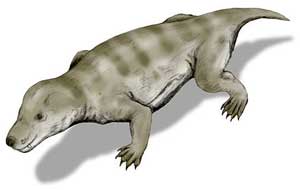
>Top 7. Evolution of life from viewpoint of glucose:
- glucose - inefficient nutrient:
- "It is usually pointed out that the brain requires glucose as nutrient; without carbohydrate our brain could not function well."
- Brain can use glucose and ketone bodies (both are water soluble); not use fatty acid (lipid soluble).
- Ketone bodies are water soluble molecules (acetoacetate, β-hydroxybutyrate, and acetone) produced in the liver from fatty acids during fasting period, or carbohydrate restrictive diets. (gluconeogenesis)
- Function of brain:
- To collect and analyze big data from visual, auditory, and other sensors.
- then transmit orders to the muscles of body for necessary action.
- human brain has 25-35B nerve cells (30GB) networked with synapse.
- neurotransmitter issued from each synapse can transfer information to other nerve cells.
- What if fatty acid freely passable fatty acid, which may disturb movement of neurotransmitter.
- >Top Brain devised not to allow fatty acid to pass through (BBB, Blood-Brain Barrier, which make glucose and ketone bodies pervious, but fatty acid impervious.)
- There is similar function in the peripheral nervous system; BNB, Blood- Nerve Barrier.
- DHA (Docosahexaenoic acid), contained in fish oil, can pass BBB.
- EPA (Eicosapentaenoic acid) can also pass BBB to support synaptic plasticity.
- both glucose and ketone bodies are water soluble, which cannot pass through cell membrane; which need some transporter to pass through.
- Transporter is convenient to control from the brain.
- Organization which uses glucose is 1) brain, 2) retina, and 3) red corpuscle.
- Red corpuscle has no mitochondria, without which no fatty acid is used.
- Glycolysis is the metabolic pathway to covert glucose into pyruvate; anaerobic metabolism (2 mol ATP produced from 1 mol glucose)
- >Top Animal activity depends on blood glucose level:
- higher blood glucose level (around 300 mg/dl): birds
- Theropoda; having air sac; including tyrannosaur, and birds
- middle level (around 100 mg/dl): most mammals and lizard
- lower level (around 30 mg/dl): snake, tortoise, sloth
- maintenance mechanism keeping appropriate blood glucose level is always life-and-death condition for animals.
- sensor to dropping blood glucose level; (glucagon, adrenaline, cortisol, growth hormone)
- insulin is the only hormone to drop the glucose level.
- mechanism to supply glucose to maintain the level.
- A hypothesis:
- Brain mechanism was designed in earlier stage of multicellular organism. The metabolic system using glucose was then most updated design. Thereafter the system using fatty acid appeared.
- The process of evolution of creatures tends to utilize gradual or minor changes of the existing system as much as possible; such as temporomandibular joint (jaw joint) from gill mechanism, or auditory ossicles from the former.
- Glucose metabolism is anaerobic which was the popular and major system in earlier anaerobic environment, but after the increase of O2 levels, new disperse nervous system (later becoming the central nervous system) which is glucose metabolism in aerobic environment, a kind of high powered engine appeared. Muscles are operated by both hybrid engines.
7. ブドウ糖から見る生命の進化:
- ケトン体:
acetone (アセトン); acetoacetic acid(アセト酢酸), β-hydorxybutyric acit (βヒドロキシ酪酸)
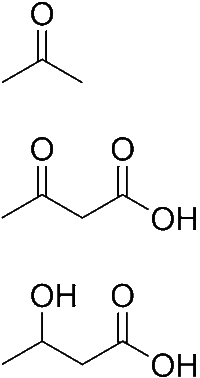
- 血液脳関門 (BBB)
- 血液神経関門 (BNB)
- ブドウ糖とケトン体は水溶性
- ブドウ糖を利用する組織は
脳・網膜・赤血球
- 解糖系(嫌気性代謝)
- 活動性は血糖値で決まる。
Food
Animal
mg/dl
omni.
birds
250-350
herb.
bighorn sheep
197
herb.
chinchilla
180
omni.
mouse
80-180
carni.
fur seal
168
carni.
lynx
101-153
carni.
cat
71-148
herb.
rabbit
135
omni.
lizard
100-130
omni.
dog
75-128
omni.
pig
70-120
carni.
wolf
118
herb.
horse
75-115
omni.
tortoise
15-90
herb.
cattle
45-75
herb.
sheep
60
carni.
snake
30-40
herb.
sloth
22
>Top 8. History of life on earth:
- 3.2 ba: Cyanobacteria (the first photosynthetic bacteria), having lipid bilayer membrane.
- the first cell membrane was water soluble to intake nutrient, making simple fatty acid or triglyceride
- O2 level rises around 2.5 ba.; since many ATP are produced from fatty acid.
- 2.1ba: advent of eukaryote
- Life on the earth is segmented as follows:
- 1) >Top Archaea: methanogen, sulfur bacteria
- 2) Eubacteria: proteobacteria; colon bacteria, pneumococcus
- 3) Eucaryote: protozoa, fungi, plant, animal
- Mitochondria: methanogen absorbed α-proteobacteria as an endosymbiont and became mitochondria.
- Snowball Earth:
- >Top It is assumed that the Snowball Earth phase occurred at least three times: 2.45- 2.2 ba (Huronian glaciation), 760-700 ma (Sturtian glaciation), and 620-550 ma (Marinoan glaciation)
- After covered by snow, Albedo (reflection coefficient) drastically accelerated cooling down of the earth.
- Limited number of creatures including cyanobacteria could survive the snowball earth; then O2 rich atmosphere supported favor for eucaryote; particularly α-proteobacteria which can continue effective aerobic metabolism as a symbiont (19 times efficient than anaerobic metabolism); weak coalition creature could be a winner in aerobic environment.
- Both archaea and eubacteria can do only anaerobic metabolism, which were forced to escape to the anaerobic environment.
- >Top It looks marvelous that α-proteobacteria retained aerobic metabolism until the increase of O2 level.
- Then around 1.5ba multicellular organism appeared;TCA cycle can produce 4 times of ATP.
- During the severe environment of snowball earth period, organism established the method of stock of energy:
- Plant organism: changing glucose into insoluble polysaccharide.
- Animal organism: storing in the form of triglyceride (neutral lipid)
- >Top Evolution of multicellular organism:
- Ectoderm only
- Ectoderm and mesoderm
- Ectoderm, mesoderm and endoderm
- Mesoderm in one of the three primary germ layers in every embryo of bilaterian animals.
- Ectoderm develops to epiderm (or external sensor), then differentiate to disperse nervous system, while endoderm to digestive tract (or alimentary canal).
- In Ediacala period (635-542ma), Ediacala organism evolved explosively from several cm to more than 1 m. (Avalon explosion)
- In Cambrian period (542-485ma); animals having vision (eyes) appeared.
- Visual sense (ophthalmocepton) is more sensitive than olfactory (olfacoception) in different order of magnitude.; advent to carnivorous animals.
- Evolutionary arms race: sharpening well eyes, muscles, and nerve system; where new engine named lipid metabolism, or hybrid engine of glucose and lipid metabolism.
- then evolved to protect nerve system surrounded by blood vessels with BBB function from fatty acid.
- Glycogen:
- polymer connected by glycosidic bond of glucose; mostly stored in liver and muscle.
- Glycogen is a kind of one-point relief in contingency, while fatty acid succeed it in usual cases.
- Glycogen is store about 100g in liver, and 300g in muscle; we have three decomposing hormones (glucagon, adrenaline, and growth hormone), but have only one synthesizing hormone (insulin).
8. 地球上の生命の歴史:
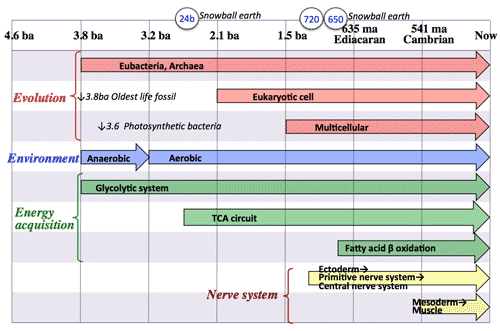
- 真核細胞の登場:
- 全球凍結:
- 真核細胞の進化:
- 古細菌: アーキア; メタン生成菌・イオウ分解菌
- 真正細菌: バクテリア; 大腸菌・肺炎球菌
- 真核動物: ユーカリア; 原生動物・真菌類・植物・動物
- 古細菌がαプロテオバクテリアを胞内共生体
- ATPは全てミトコンドリアが生成
- α-プロテオバクテリアは、好気性・嫌気性のハイブリッド代謝が可能。
- TCA-cycle
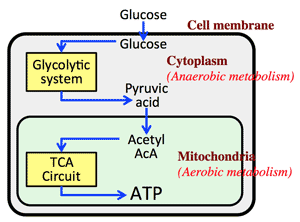
- 多細胞生物の進化:
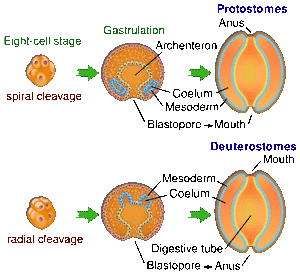
- 全球凍結は真核生物にとってチャンス:
- 過去に3回以上全球凍結が起こっている。
- 海水も1000mまで凍結
- 極地は-90ºC、赤道でも-50ºC
- 原因は超大陸の生成とシアノバクテリアによるCO2消費(温室効果の減少)
- 原始真核細胞にとって、細胞内共生体であるα-プロテオバクテリアが好気性代謝ができたことが幸運
- グリコーゲン:
>Top 9. The origin of agriculture viewed from carbohydrate:
- In the three major nutrients, only carbohydrate can be taken from plant food, while protein and fatty acid from plant and animal food.
- human beings (before 17C) had little carbohydrate.
- Agriculture started around 12000 years ago in fertile crescent areas, where wheat is the major plant.
- productivity was 1.7 times by rainfed agriculture.
- 200 times by oasis irrigation agriculture.
- life style changed from hunting and gathering to sedentary agriculture life
- What is grain?: food of starch-rich seeds.
- composed of embryo developing as leaf or root and endosperm as a food store.
- The world population:
- was 5-10m 10000 years ago, which increased over 100m by 0 year AD
- increased over 1.0b the time of the industrial revolution.
- Nutritional balance:
- in hunting & gathering ages: healthy but less populated
- in agricultural ages: unhealthy and over populated; replant failure
- crops are excellent foods to satisfy the hunger, but carbohydrate is not what the body requires as nutrient.
9. 糖質から見た農耕の起源:
- 三大栄養素:
蛋白質と脂質は動植物性だが、糖質だけは植物性
- 人間は17C頃までほとんど糖質は採っていない。
- 麦: オアシス潅漑により200倍の収穫
- 穀物とは澱粉の豊富な種子: 葉や根に発達する胚と、栄養分の貯蔵庫である胚乳からなる。
- 世界の人口:
- 10000年前は5-10m、西暦0年頃1億人超える。
- 産業革命の頃10億人以上
- 栄養バランス
- 狩猟採集: 健康的、人口希薄
- 農耕: 不健康、人口過多; 連作被害
- 糖分は飢えを満たすには優れた食物だが、体が求める栄養素ではない。
Comment
- This is a 'the scales drop from my eyes' or 'the glucose dropping from my body' book, and is useful to reconsider metabolic syndrome.
- The author is a medical doctor who may also understand the essence of geological knowledge.
- 本書は目から鱗、いや体から糖質が落ちる本であり、メタボ・シンドロームを再考するのに役立つ。
- 著者は、地質学的な知識の本質を理解しているであろう医師である。
>note |
Carbohydrate may destroy human beings- Life science reviewed from restriction of taking glucide -
|
Cat: SCI |
Makoto Natsui (夏井 睦) |
16515u/18227r |
Résumé |
Remarks |
>Top 0. Introduction:
|
0. 序文:
|
>Top 1. Impact of restriction of taking carbohydrate
|
1. 糖質制限の威力:
|
>Top 2. Basic knowledge of restriction of carbohydrate:
|
2. 糖質制限の基礎知識:
|
>Top 3. Problems by restriction of carbohydrate:
|
3. 糖質制限の問題点:
|
>Top 4. Also sprach a restrictionist:
|
4. 糖質セイゲニストかく語りき:
|
>Top 5. New horizon seen by the restriction of carbohydrate:
|
5. 糖質制限すると見えてくるもの:
|
>Top 6. Amount of calories in food:
|
6. 食物のカロリー数:
|
|
|
>Top 7. Evolution of life from viewpoint of glucose:
|
7. ブドウ糖から見る生命の進化:
|
>Top 8. History of life on earth:
|
8. 地球上の生命の歴史:
|
>Top 9. The origin of agriculture viewed from carbohydrate:
|
9. 糖質から見た農耕の起源:
|
Comment |
|
|